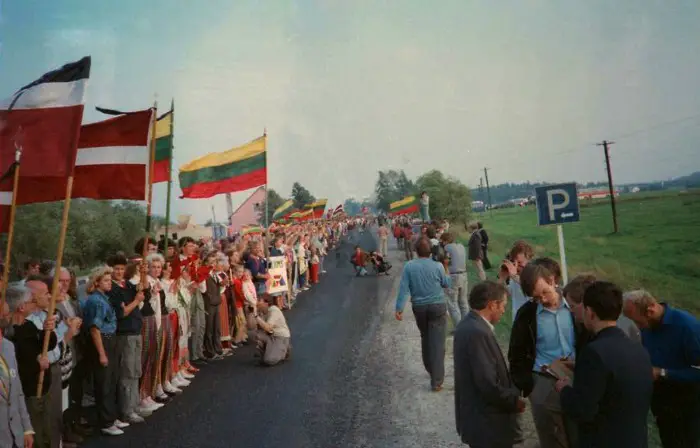 August 23, 1989, 50 years after the signing of the Molotov -Ribbentrop Treaty, about two million people gathered to protest peacefully against the occupation of the Baltic States. People from the three Baltic States formed a human chain that stretched for 600 km, wanting to show the whole world the desire for independence, but also the solidarity that united them.
August 23, 1989, 50 years after the signing of the Molotov -Ribbentrop Treaty, about two million people gathered to protest peacefully against the occupation of the Baltic States. People from the three Baltic States formed a human chain that stretched for 600 km, wanting to show the whole world the desire for independence, but also the solidarity that united them.
Molotov-Ribbentrop Pact
During World War II, on August 23, 1939, the Molotov-Ribbentrop Pact of Non-Aggression was signed, named after the German and Russian foreign ministers who signed the document, Viacheslav Molotov and Joachim von Ribbentrop. Through this pact, the two divided Eastern Europe and the Baltic countries into German and Soviet spheres of influence.
As a result of the implementation of the Perestroika government policy, protests intensified, both inside and outside the USSR. In 1986, protests took place in major cities, such as Los Angeles, New York, London, Ottawa, Washington, and people wanted to sound the alarm about human rights abuses by the Soviets.
In the late 1980s, the effects of the pact were still being felt as the Soviets still had some control over the Baltic states. Moreover, the Soviet Union strongly stated that the three countries willingly wanted to be members of the USSR. Fifty years after the pact was signed, the people of the three states demanded that the secret of the pact be made public and wanted the independence of the Baltic territory.

The tensions between the Soviets and the Baltic states were growing. The Lithuanians managed to collect over 2 million signatures on a petition which detailed the Lithuanian people’s will for the withdrawal of the Red Army. The Soviets were afraid of a violent reaction from the protesters, but the leaders of Romania and East Germany, Nicolae Ceausescu and Erich Honecker promised them armed aid in case they had to quell the revolt.
The Baltic Way

As for the origin of the idea of the human chain of August 23, 1989, no one knows where it came from. At 7 o’clock in the evening, about 2 million people shook hands and formed a chain that passed through all three capitals: the chain started from Tallinn, passed through Riga, and reached Vilnius.
The organizers of the event drew a map so that the chain would be uninterrupted. Some factories gave workers a day off to attend the event, others funded their transportation.
In Estonia, everyone was released from work throughout the country. There were special shows on the radio promoting the event.

The activists drafted a petition to the European Community demanding the annulment of the pact, given that it violated human rights. 700,000 Estonians, 500,000 Lithuanians, and 1,000,000 Latvians took part in the human chain, according to Reuters. Protesters took place in Berlin, Moscow, Leningrad, Toronto, and Tbilisi, but also in other parts of the world.
The “Freedom Chain” or “Baltic Chain” is the most important campaign organized by the Baltic States in their bid to free themselves of the Soviets. Following the protest, the Soviet Union acknowledged the existence of the pact and declared it invalid, one of the most important steps taken for the independence of the Baltic states.

The solidarity between the three states attracted international sympathy and was an impetus for new democratic actions by other states, but also an impetus given to Germany for unification. The documents attesting to the Freedom Chain were added in 2009 to the UNESCO World Memory Register.
Avid Writer with invaluable knowledge of Humanity!
Upcoming historian with over 30 million views online.
“You make your own life.”





